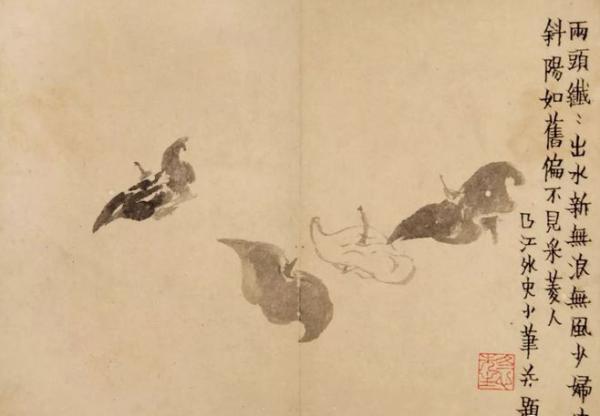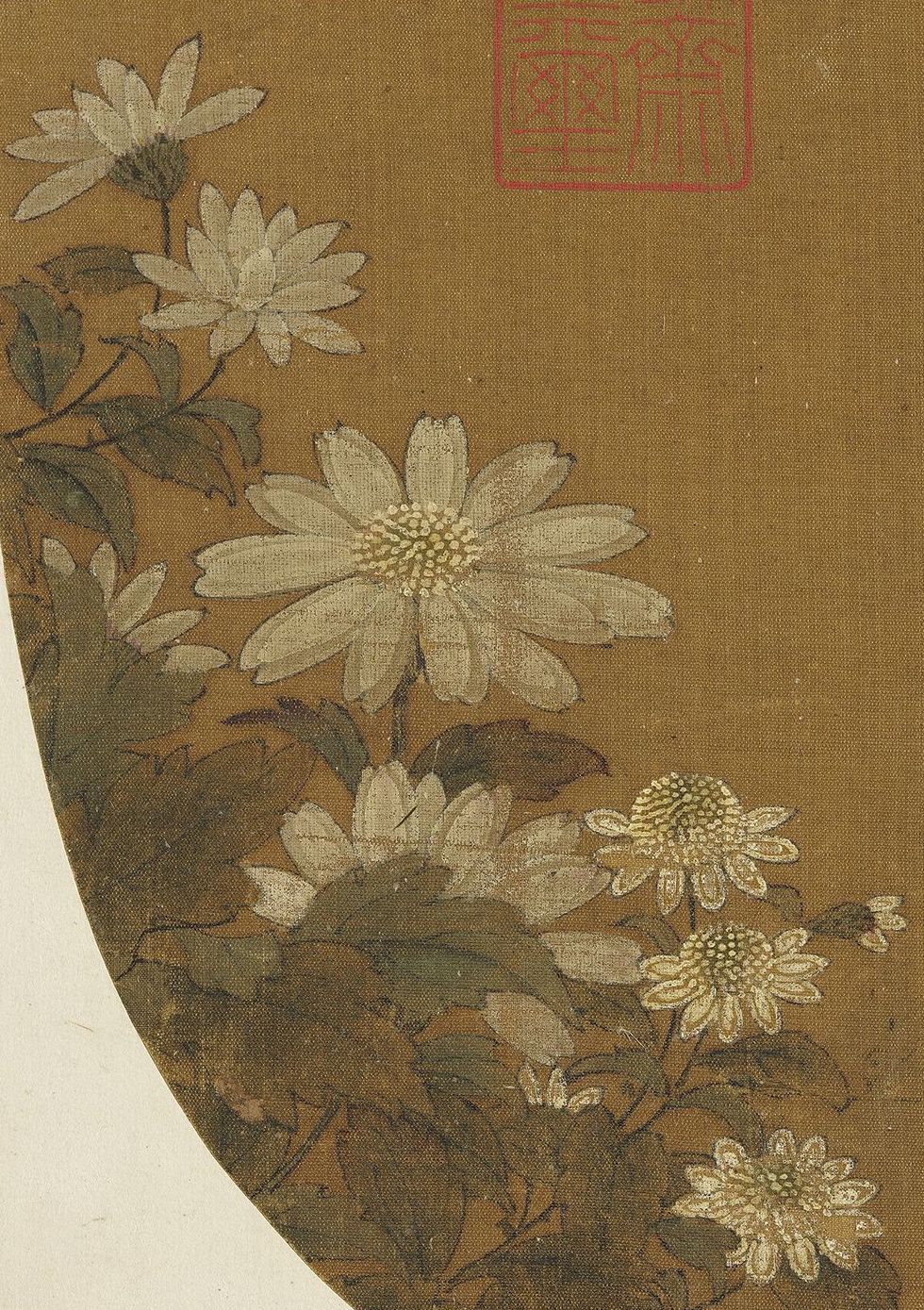
Today is the beginning of autumn. The poem "The Beginning of Autumn" written by Liu Yanshi of the Tang Dynasty includes: "This is the morning to stop the fire, Shang Biao has already been frightened. The sky has gathered its summer color, and the wood leaves are moving with the sound of autumn."
There are three phases in the Beginning of Autumn: "The first phase is when the cool breeze arrives; the second phase is when the white dew grows; the third phase is when the cicadas chirp."
The best time to eat melons and meat is to eat autumn fat at the beginning of autumn... "Jinmen Miscellaneous Notes: Customs of the Year" of the Qing Dynasty recorded: "Eating melons at the beginning of autumn is called biting autumn, which can avoid diarrhea." Some places also call it this. It is called "gnawing autumn", which means that the hot summer is unbearable, and it is the beginning of autumn, so bite it.

"Peach and Melon Picture" from the Flower and Fruit Album of the Ming Dynasty, collected by the National Palace Museum in Taipei
The Beginning of Autumn is an important traditional festival in China, known as the "Beginning of Autumn Festival" in ancient times. People will hold a series of activities to welcome this seasonal change. As early as the Zhou Dynasty, on the first day of autumn, the emperor personally led the three princes, nine ministers, and princes and officials to "welcome the autumn" and held a sacrificial ceremony in the western suburbs. This custom was inherited in the Han Dynasty, and animals were killed as sacrifices to express the coming of autumn and the promotion of war.
In the Tang Dynasty, sacrifices were also made to the Five Emperors on the first day of autumn. "New Book of Tang·Book of Rites and Music": "At the beginning of autumn and winter, the Five Emperors were worshiped in the surrounding suburbs." In the Song Dynasty, on the day of the beginning of autumn, both men and women wore autumn leaves to match the time sequence. There is a custom of cutting petals from heather red leaves and inserting them into hairpins on the temples, and there is also a custom of swallowing seven small red beans with autumn water (see "Lin'an Chronicles").
In rural areas, it is customary to predict whether the weather will be hot or cold during the day or night at the beginning of autumn. There is also the custom of eating watermelon and green beans to try new things and pay homage to ancestors. On the day before the beginning of autumn, it is also customary to drink iced melon, steamed preserved eggplant, and fry fragrant wormwood.
At the beginning of autumn, bite the autumn
Regarding the Beginning of Autumn, Fan Cheng of the Song Dynasty wrote a great poem: "When the branches and catalpa leaves are broken, the melons rise in the garden, and the red beans are like pearls swallowing well flowers."
Melons are a common theme in Chinese calligraphy, painting and arts and crafts. In addition to depicting their shape, they also focus on capturing their charm.
Among the famous paintings of melons, there are "Autumn Melon Pictures" by Qian Xuan of the Song Dynasty, ink watermelon albums by Bada Shanren of the Qing Dynasty, "Japanese Melon Shaft" by Qi Baishi, and also round and plump melon-style melon-shaped teapots and melon ridges from the Ding Kiln of the Song Dynasty. Jars, as well as melon-style stationery utensils with unique craftsmanship.
"The Book of Songs·Daya" records: "Continuous melons and melons are the birth of the people." Later generations often quoted the four characters "Mianmian melons" to represent the meaning of having many children and grandchildren, and a prosperous family. And melons and fruits with many children also have similar auspiciousness. mean.
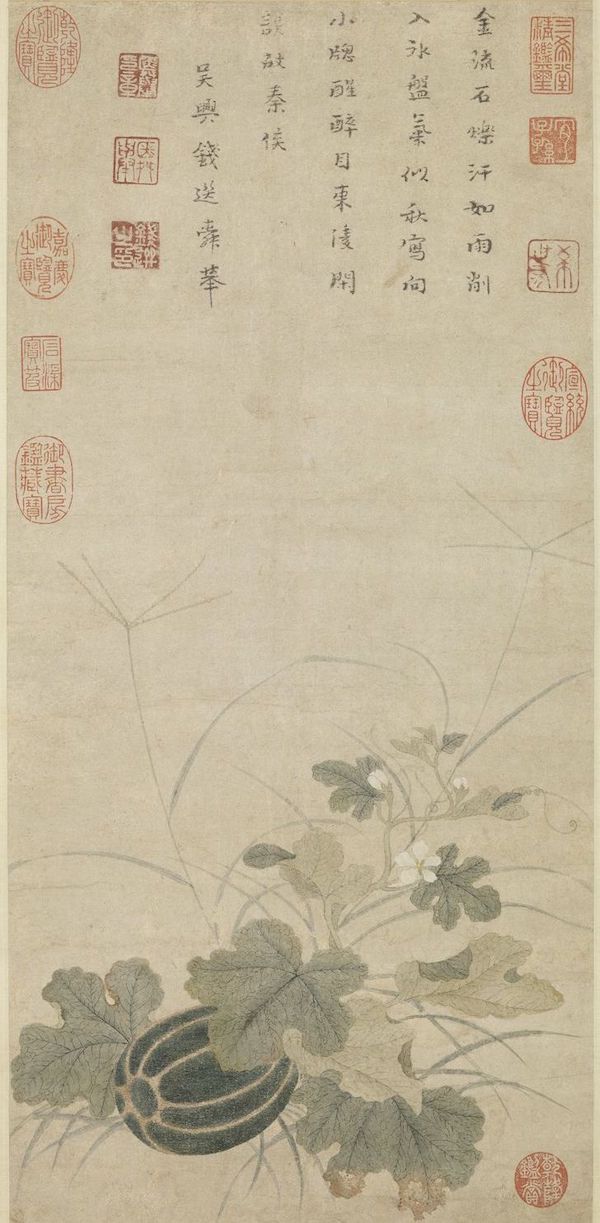
"Autumn Melon Picture" by Qian during the Song and Yuan Dynasties, collected by the National Palace Museum in Taipei
Qian Xuan, courtesy name Shunju, was born in Wuxing, Zhejiang. In the third year of Jingding in the Southern Song Dynasty (1262), he was a Jinshi from the township. He was good at poetry, calligraphy and painting, and enjoyed a reputation in the local literary and art circles. In the early Yuan Dynasty, he and his friends Zhao Mengfu and others were called "Eight Talents of Wuxing". The "Autumn Melon Picture" from the collection of the National Palace Museum in Taipei depicts round melons, palm-shaped leaves, slender grass whiskers, and small white flowers in various shades and different levels of green. The color is clear and beautiful. The melon leaves are bent or raised, with various curling and turning postures. The leaf veins are also carefully painted, and even the insect-eaten areas are meticulously painted, exuding a quiet and elegant atmosphere. The exquisite and elegant style of the whole painting still has the legacy of Southern Song Dynasty paintings, but the sweet and mature flavor has faded. The theme of painting melons is related to the auspicious meaning of continuous melons and many children, which obviously meets the needs of the market. There is also a poem written by the author at the top of the painting, which is sealed in all directions. However, some scholars believe that this work may be a work of a later generation based on the painting style and style.
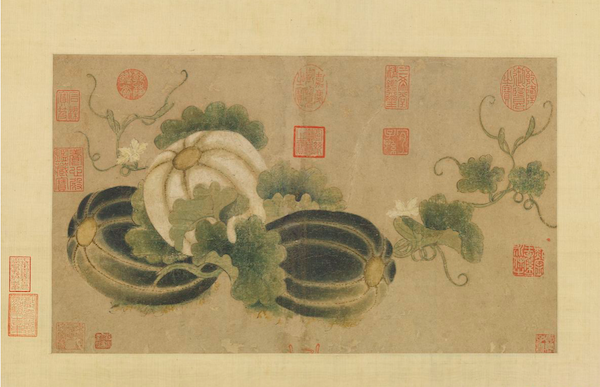
"Autumn Melon Picture" by the Song Dynasty, collected by the National Palace Museum in Taipei
Similar compositions to the scroll of "Autumn Melon Picture" include the Song Dynasty's "Autumn Melon Picture" scroll and the Song Dynasty's "Pictures of Painting Grass, Insects and Melons" which is included in the Song Dynasty's album. Among them, the "Autumn Melon Picture" of the Song Dynasty depicts three autumn melons growing on the ground, with vines, leaves, flowers, etc. embellished among them. The skin of the melon is dyed with old green stain, and the edges of the melon are filled with ocher yellow, which is extremely descriptive and full of charm. The weft and tendrils of the melon leaves are all carefully outlined, using a round and delicate brush. There is no author's name on the painting, and the delicate brushwork used on this scroll is similar to that of the Song Dynasty's "Cao, Chonggu and Real Pictures". Therefore, if this scroll is not from the Song Dynasty, it must be the work of Qian Xuan's late generation. The ink watermelon album page is one of the "Zhuanqi Sketch Album" collected by the National Palace Museum in Taipei. There are three paragraphs of inscriptions in regular script and running script written by Badashan people in the album. One paragraph is: "He Pan dug out a big watermelon. There is sand in the eyes for no reason. I send a message to the natives to stop laughing. To clear away the weeds is like hemp." "
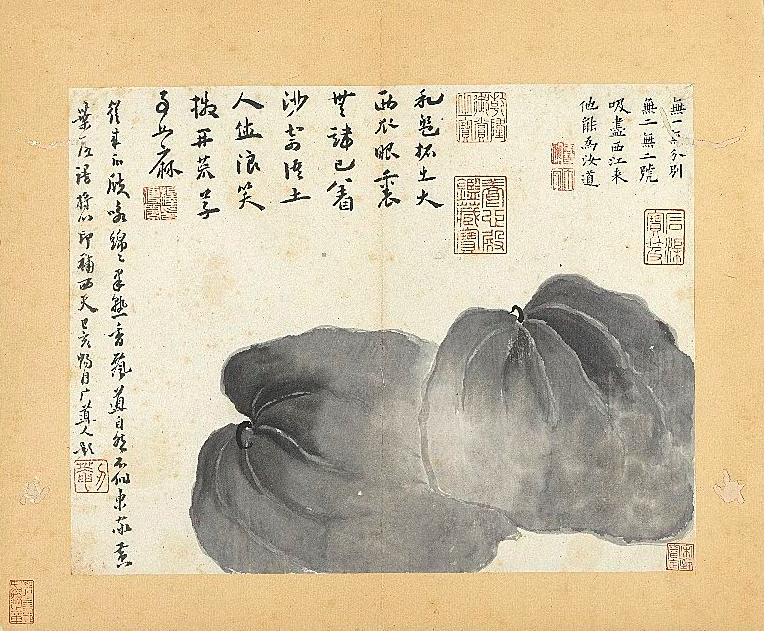
Bada Shanren Ink Watermelon Album Collection of the National Palace Museum, Taipei
Qi Baishi, a master of modern painting, painted a large number of works with the theme of melons and fruits throughout his life. Among them, the "Japanese Melon Scroll" collected by the Palace Museum uses ink and splash ink to depict Japanese melons with lush vines and leaves, and the style is "Old People of Xingziwu". The scroll "Gua Lian Mian Mian" in the collection of the National Palace Museum in Taipei uses both outline filling and boneless techniques to depict the image of a pumpkin hanging from a vine that is bent and twisted. In addition to pumpkins, Qi Baishi also wrote about loofah and so on.

Qi Baishi's paintings
Using meat to gain fat is good for health
Among the customs of the Beginning of Autumn, the most important one is sticking autumn fat. In ancient times, it was believed that increasing food intake in autumn could help the body store energy to cope with the cold winter. Therefore, putting on autumn fat has become an important custom.
In the north, on this day, ordinary people eat stewed meat, and more sophisticated people eat white-cut meat, red-braised meat, as well as meat dumplings, stewed chicken, stewed duck, braised fish, etc.
After most people experience a summer, their weight will be lighter than that at the beginning of summer. Northern folk have the custom of weighing people by hanging scales at the beginning of autumn, and use the results as a judgment on health. If your weight is lighter than at the beginning of summer, you need to take supplements. "Putting meat on fat" is actually a good thing for health.
In addition, drying in autumn means that on the day of the Beginning of Autumn or in the days after, people will dry crops such as grains, beans, vegetables, etc. in the sun in order to store them. Sunbathing in autumn also has the meaning of driving away evil spirits and praying for a good harvest.
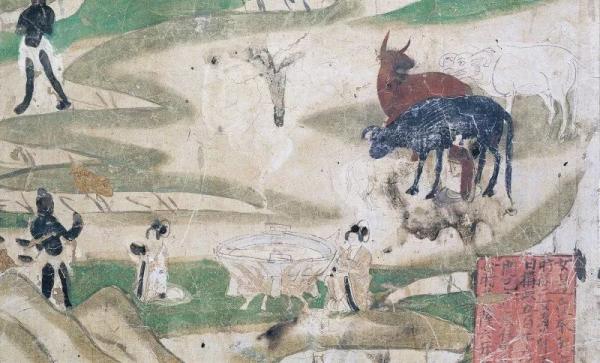
Village girls from Cave 61 of Mogao Grottoes donated breast milk for five generations
In ancient Dunhuang murals, scenes of meat can often be seen. Meat is an important part of the Dunhuang people's dietary structure. Its sources are mainly raised livestock, poultry meat and hunted wild animals. In particular, the raised mutton has become the protagonist on the Dunhuang people's table.
In addition to the usual mutton, it is also great to have some game meat occasionally.
Autumn is suitable for hunting. "Book of Rites·Yue Ling" says:
"It is the month of the month, and the emperor is teaching people to hunt in the fields... holding a bow and an arrow to hunt, and ordering the Lord to sacrifice birds in the temple in all directions."
Especially the princes and nobles regard this as a field fun that cannot be missed every year. They gather a few people, go out with bows and head for the prey.

The Langa Sutra in Cave 85 of Mogao Grottoes appeared in the late Tang Dynasty
People in the Tang Dynasty were very particular about hunting. Hunters all dressed up to go hunting, wearing futou, crotchless shirts, and half-waist boots. The equipment is also complete: some have eagles on their arms, some are holding dogs with one hand, some are holding bows and quivers, they are full of style, and there are even some carrying axes.
Famous Calligraphy in Early Autumn
Among the ancient writings about autumn, Su Shi wrote "Man Ting Fang" when he was exiled to Huangzhou, and Mi Fu's "Light Ink Autumn Mountain Poems", although it is said to be "light ink", is actually thick ink, which shows the spirit. Mr. Wu Changshuo carved "Xu Su" in the early autumn of Renzi, and wrote in the margin: "All wisdom and words are born from Xu Su, and there is no evil desire." There is also a statue of Bodhidharma sitting in meditation, with the text on the painting: "The couch can be worn to sit on." The gatha has no fall, Master Yi Jin Jing taught it to me."
When Su Dongpo, the great writer of the Northern Song Dynasty, was serving as the general magistrate of Hangzhou, there was a long summer drought in Hangzhou. On the day of the Beginning of Autumn, two county magistrates from Hangzhou were invited to come together to Lingyin Temple by the West Lake to pray for rain for the people. They stayed in the temple that night and wrote "Praying for Rain at the Beginning of Autumn and Staying at Lingyin Temple with Zhou Xu Erling": "A hundred heavy piles I lay down on my bed, the sound of autumn leaves fell on my bed, and the moon fell into my bed. I felt the sound of the rugged world in my pillow, but my heart of compassion for the farmers was still there. Yunhan was even more confused."
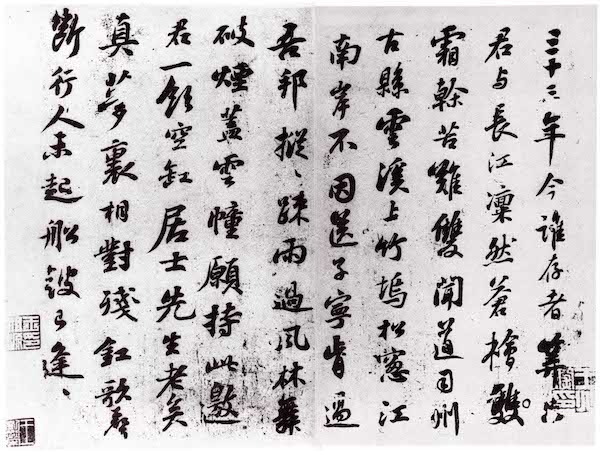
Su Shi's "Man Ting Fang"
In the Qing Dynasty, Yi Bingshou wrote in the New Autumn Period that "the book has a thousand years of correspondence, and the appearance of the family has passed twice", which is simple and simple, and contains vitality. "Four Poems of Reflections on the Nine Autumn Periods" written in fine cursive script: "I am so proud of my talent that I am not Qu Zi, but I don't know how much I admire Zang and his grandson. My father has been frightened for hundreds of years, and his arms and legs are covered with flags. But after I left, the Tongxiang Xixiu repeatedly reported that I have no years." Comfort me."
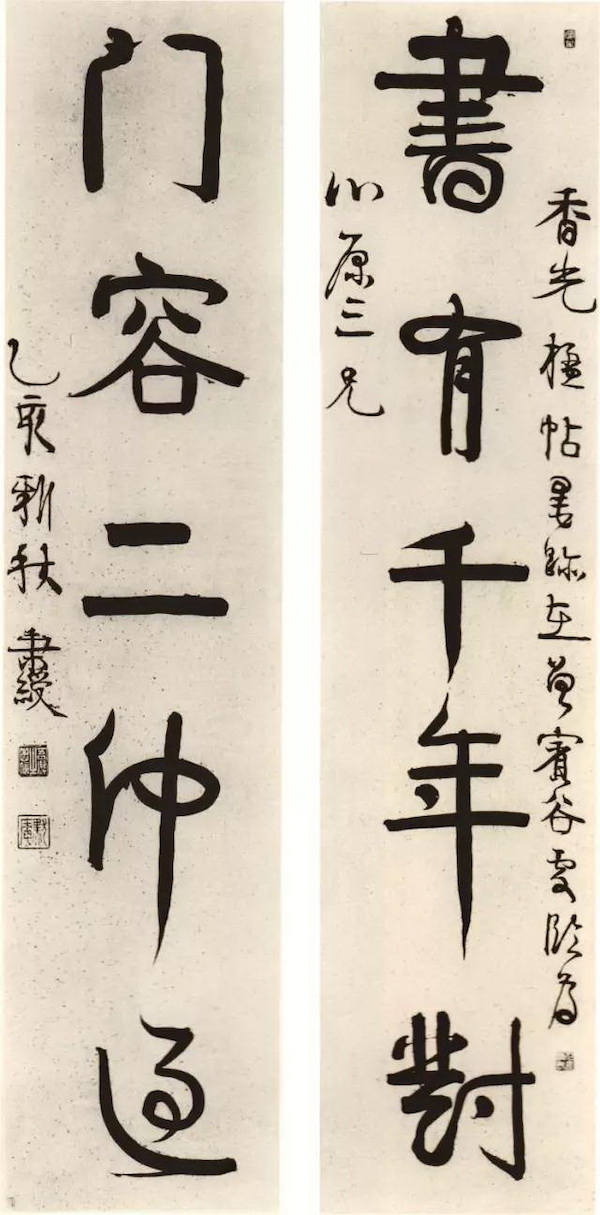
Yi Bingshou calligraphy

Yi Bingshou calligraphy
The "Maple Window" seal was engraved by Wu Changshuo, a middle-aged master of the Shanghai School, with the inscription "On the autumn day of Guiwei, Wu Jun imitates the ancient times". He was 40 years old at the time and still used the name "Wu Jun". After that, he completely wandered into the world of poetry, calligraphy, painting and sealing. "Renzi Beginning of Autumn" is engraved with "Xu Su". Wu Changshuo was 69 years old. The margin wrote: "All wisdom and words are born from Xu Su and there is no evil desire."
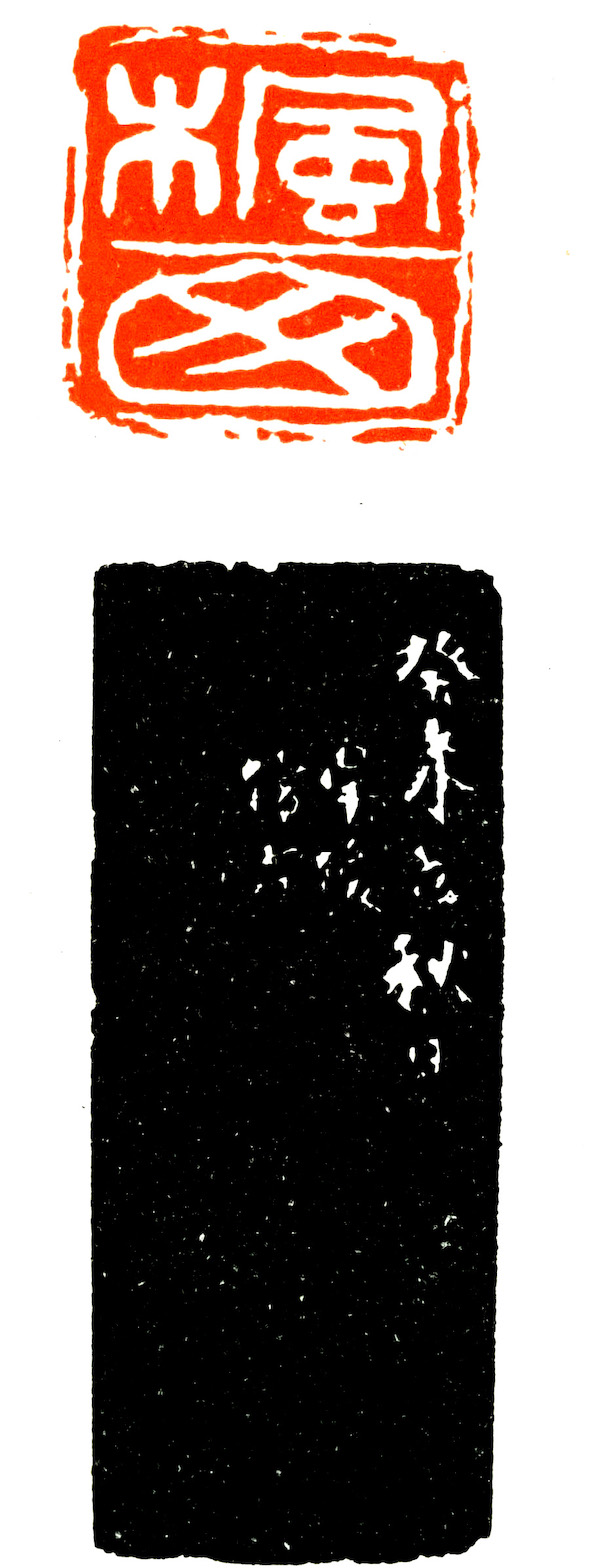
In modern times, Wu Changshuo carved "Maple Window" to mark the beginning of autumn in Guiwei.
(This article is based on a comprehensive compilation of relevant folklore literature and The Paper materials)
